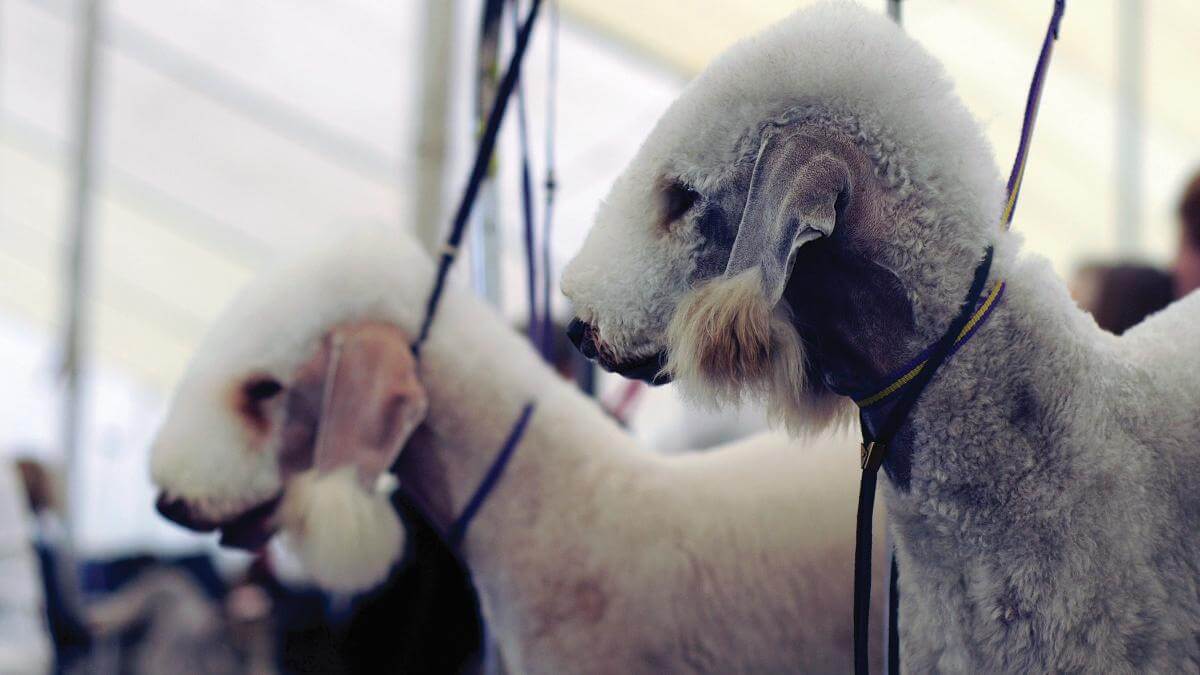


Home » The Bedlington Terrier

This article was originally published in Showsight Magazine, May 2013 issue.
I never really fully appreciated the exceptional qualities of my Bedlington Terriers until I owned and operated a public boarding kennel and had to care for many different breeds. The constant clean up of copious amounts of hair; the nervous and unsure dogs that refused to eat and drink; the dogs that resisted necessary grooming care all came as a rude awakening to me. My credo became, “Oh, if I could only afford to limit my clientele to Terrier breeds, primarily Bedlingtons, life would be wonderful!” After over 30 years of breeding and exhibiting Bedlington Terriers, I never tire of listening to my clients’ superlatives about the breed: “I can’t imagine going through life without a Bedlington”, “I’ve always wanted a Bedlington since I saw one when I was nine years old”, “I’m glad I didn’t have to go through life without knowing how wonderful Bedlingtons are”, “We had other breeds after our Bedlington, but want another one” and the best of all, “If I had known how great Bedlingtons were, I would not have had children!” Now that’s a testimonial. They are engaging, they are endearing and if you can get to the grooming shop regularly, the rest of it is a cakewalk.
Much has be said and written over the years about the ferocity of an aroused Bedlington, their ability to kill prey and their unpredictable rivalry with other dogs, but to see a Bedlington’s tender affection for a stranger in a nursing home is an amazing sight. They are tremendously effective therapy dogs and we already have a few that have earned recognition from the American Kennel Club for their therapy work. Did you know that Bedlingtons can compete successfully in lure coursing? We now have a few titleholders in that pursuit. The breed has excelled in the various other performance events that they are eligilble for. We have agility Bedlingtons that have earned MACH titles up to the 9th level. We have UDX Bedlingtons in obedience and some high achievers in Rally. Not surprisingly, the Master EarthDog titleholders are quite numerous. Greatly surprising are the few Bedlingtons that are Schutzhund dogs. Bedlingtons are a low population breed with less than 200 individual dog registrations recorded every year.
However, the breed enjoys an enthusiastic fancy, with a parent club that boasts over 300 members and exhibitors that finish conformation titles on at least 50 dogs a year. We are fortunate to have a wealth of literature about the breed, considering it’s low population. A comprehensive bibliography can be found on the parent club’s website, bedlingtonamerica.com. The breed books are richly illustrated with photographs, and there are several authored by Muriel Lee and some from experts in the mother country of our breed in Great Britain, Ken Bounden and Ian Phillips. The breed is most fortunate to have been chosen as a subject for the original research to develop a molecular genetics test to identify carriers of a major hereditary disease, inherited copper toxicosis. Many affected dogs would succumb to liver failure, some prior to their third birthday. The test developed at the University of Michigan in 1994 has now virtually eradicated the disease in the breed and became the impetus for the formation of the AKC Canine Health Foundation.
Like all mammals, Bedlingtons suffer from a few other inherited diseases, but the majority of identified maladies in the breed are not life threatening and nor are they difficult to manage. The parent club opted to participate in the Canine Health Information Center established by the Orthopedic Foundation For Animals and the tests designated for registration in the scheme are the aforementioned DNA Markers for Copper Toxicosis, OFA Patellar Luxation clearance after the first birthday and a yearly eye exam by a ACVO certified ophthalmologist. Despite the low population, the need for rescue efforts arises occasionally. Our breed fancy started organized rescue in the late 80s before the practice was widespread. A Bedlington has never gone wanting for care and a new home, thanks to some conscientious and dedicated fanciers. One of the greatest testimonials for the breed occurred with a dog that I personally rescued. He was imported from Russia by a Missouri puppy miller, passed along to another puppy mill in Kansas that was raided. We were notified that there was a male Bedlington in a state authorized shelter, however he was considerably larger than the standard.
I was able to get the dog released after being neutered and I tested his DNA markers for copper toxicosis which would also affirm that he was pure-bred. He was and a non-carrier, so I sent him to a new home shortly thereafter. What was truly remarkable, was his easy adjustment, after 6 years of being kenneled in puppy mills and shelters, he acclimated to his new home without missing a beat! So what do you think? A 20-pound dog that you can carry under your arm, that doesn’t shed or have a doggy odor, is happy with whatever life brings them, and is so very versatile that it can perform at a high level with other breeds that are specialized in the event. If you ever had one, you would raving with my clients!